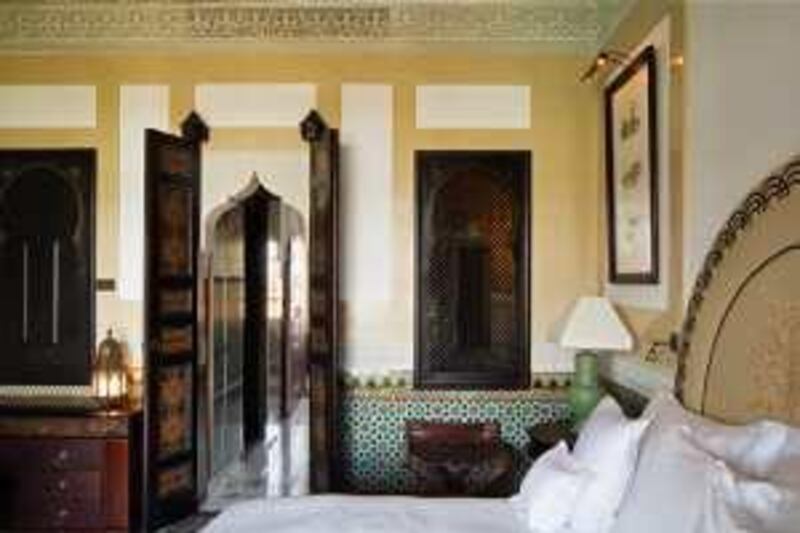MARRAKECH, Morocco // Whenever Winston Churchill came to Marrakech he stayed at the Hotel La Mamounia, taking a room with a view of the gardens and, beyond them, the white towers of the High Atlas range that spans the eastern horizon. "I must be with you when you see the sunset on the snows of the Atlas Mountains," Churchill told the US president Franklin Roosevelt after the Casablanca Conference in January 1943. Naturally, that meant a trip to La Mamounia.
Next month La Mamounia is reopening again after three years of extensive refurbishment, an extra dollop of glamour to match the recent ascent of Marrakech as a cultural and tourist hotspot. While some locals worry that growth benefits too few and is threatening the city's character, La Mamounia's elegance and distinguished history set it apart from the crowd. Churchill and Roosevelt visited the hotel two months after Morocco had fallen to American forces in Operation Torch, an Allied campaign to chase the Nazis out of North Africa. As the German Gen Erwin Rommel fled into Tunisia, the two leaders enjoyed a holiday in one of Morocco's most venerable cities.
Marrakech began life as an 11th-century trading post, where Berber tribesmen mingled with Saharan caravans. It flourished under the medieval Almohad dynasty and has served periodically as Morocco's capital. Even the country's modern name is derived from it. La Mamounia is named for its gardens, where the 18th-century Prince Mamoun threw lavish parties. The hotel was opened in 1922, attracting a glittering international clientele before Marrakech declined as a luxury destination after Morocco gained independence from France in 1956.
But the great city of palms and red battlements has rebounded in the past few years as Morocco has improved infrastructure and promoted it as a tourist attraction. "The city is becoming a jet-set destination," said Denys Courtier, the hotel's executive director. "We already have reservations from all over the world." While the global financial crisis has dented tourism in Morocco this year, Mr Courtier noted that La Mamounia was reopening as western Europe and the US start edging towards economic recovery, and benefits from special cachet.
"People who have never been to Morocco have heard of La Mamounia," he said. That renown was suggested in May when art-deco and oriental furniture from the hotel sold at auction for US$4.2 million (Dh15.4m) The renovation has been carried out by the design star Jacques Garcia, whose opulent makeovers from Las Vegas to Beirut have earned him the Legion d'Honneur, the highest distinction in his native France.
Views of the hotel from outside are obscured by the surrounding palm trees - it is inside that counts. In homage to Moroccan tradition, Mr Garcia has made ample use of carved cedar, intricate stencilling and tiny mosaic-like tiles called zellij. Marrakech's new prosperity has nourished its arts and culture scene. The city now boasts galleries, a film festival and a resident community of artists, both foreign and Moroccan.
"Not only foreigners, but also middle- and upper-class Moroccans are coming, so there's a market here," said Hamid Fardjad, an Iranian filmmaker and interior designer who co-founded the École Superieure des Arts Visuels de Marrakech. He has lived in the city since 2001. "People visit other cities - in Marrakech they stay." But Marrakech's boom may be overheating. Mr Fardjad and other artists worry that too much growth too fast is robbing the city of its charm.
"When I first came here in 2000 the city was unique and magnificent," said Nourrdine Amir, one of Morocco's leading fashion designers. "I used to be able to say that Marrakech inspired me - I can't say that anymore." The medieval core of the city and French-built quarter are ringed today by anonymous salmon-coloured housing blocks like scabs on the landscape. Modern resort hotels have sprung up overnight to serve the influx of tourists.
Meanwhile, the tourism boom has created a chaotic service industry that can turn exploitative, with few long-term contracts and pay often below the minimum wage of around Dh10 an hour, said Abdelilah Isbah, a local representative of the Moroccan Association for Human Rights. In the Jemaa al Fnaa, a vast square near La Mamounia in the heart of Marrakech, hundreds of diners sat poised over soup bowls at dozens of outdoor restaurants, waiting for the Ramadan sun to set. Some were Moroccan, some foreign.
"The advantage of tourism is that we meet people from other cultures," said Simo, 22, a waiter who did not give his surname. "But since tourists started coming to Marrakech everything has become more expensive, and unless you study at a private school you'll never make a decent wage." The call of a muezzin went up and Simo hurried off as eating commenced. Back at La Mamounia, the staff, blessed with competitive salaries and long-term contracts, were busy with a dry run of dinner. Far off to the east, above the waving palms, the last light of the sun glanced from the tops of the Atlas Mountains.
jthorne@thenational.ae





